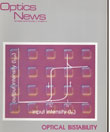
October, 1985 Issue
Feature Articles
Lasers: The First 25 Years
Since the earliest days of the utilization of the electromagnetic spectrum, there has been a steady drive toward the production and use of coherent electromagnetic energy of higher and higher frequency. This tendency resulted partly from the realization that an increase in transmitted information, directivity, and efficiency were available with increasing carrier frequency and partly as a result of crowding and interference between existing frequency bands.
by Anthony J. DeMariaDevices for Optical Signal Processing
The use of optics to perform signal processing operations has long held an attraction because speed-of-light considerations and the availability of many parallel channels in two-dimensional optical fields promised very high throughput. Many concepts for optical processing have been proposed, yet very few has ever progressed beyond demonstration stages into widespread usage. For many concepts the technology was not available for an effective implementation.
by John N. LeeIssues in Low-Vision Research
Imagine waking up one morning to discover that your vision is suddenly blurred. Over the next few days it becomes progressively worse until you can no longer make out the numbers on the alarm clock, and the picture on the wall is a jumble of fuzzy, colored patches. After a visit to the ophthalmologist, you learn that you have optic neuritis, an inflammation of the optic nerve. The inflammation gradually subsides over the next several weeks. Your vision improves, but you are left with a partially blind region in the center of your visual field reducing your acuity to 20/80. You would probably be able to read the newspaper with a magnifying glass, to navigate without the aid of a cane, and to recognize familiar faces that are nearby.
by Gary S. RubinThe Optoelectronic Industry in Japan: Development and Prospects
Since optoelectronic technology is one of Japan's areas of expertise, one can imagine that it will flourish in the world as “a technology developed in Japan.”
by Kenjiro Sakurai
![Infinity Mirrored Room– Brilliance of the Souls 2014 by artist Yayoi Kusama. [© YAYOI KUSAMA]](https://opnmedia.blob.core.windows.net/$web/opn/media/images/articles/2024/0724/departments/202407-cover-web.jpg?ext=.jpg)
![An experimental scheme demonstrated by researchers at Princeton and Yale universities, USA, can convert physical noise into errors that can be corrected more easily. [F. Wojciechowski, Princeton University]](https://opnmedia.blob.core.windows.net/$web/opn/media/images/articles/2024/0624/departments/202406-cover-web.jpg?ext=.jpg)
